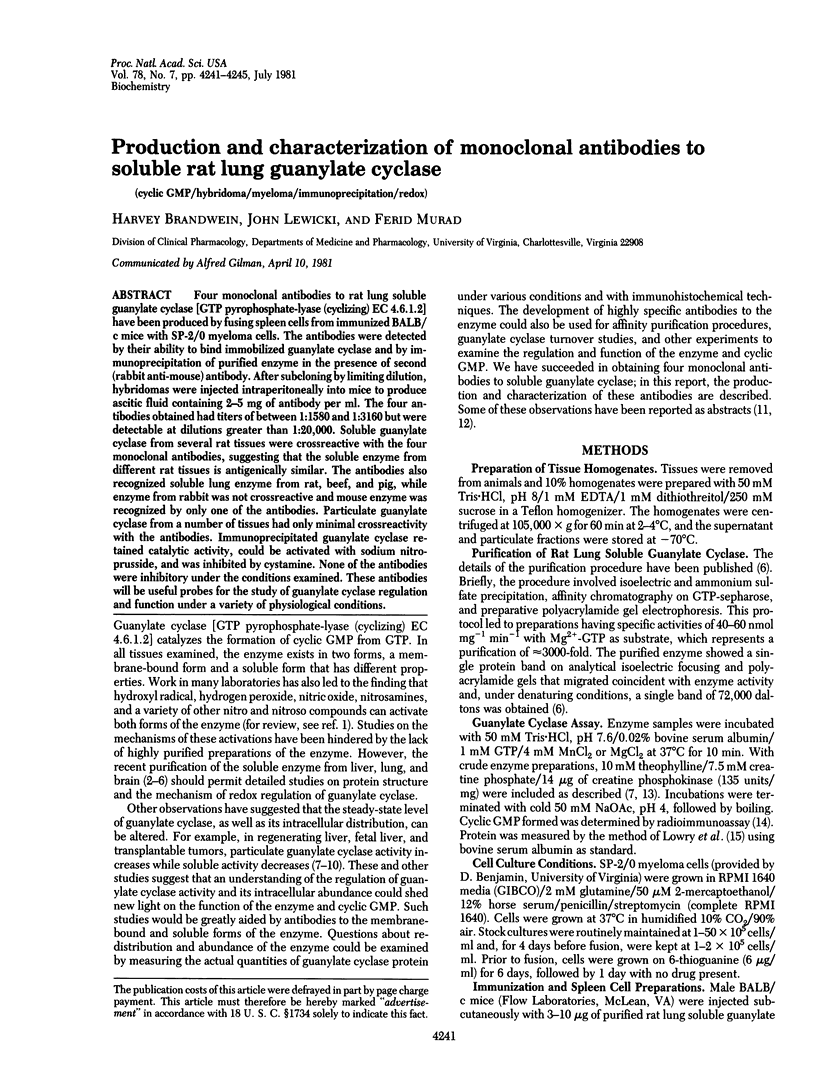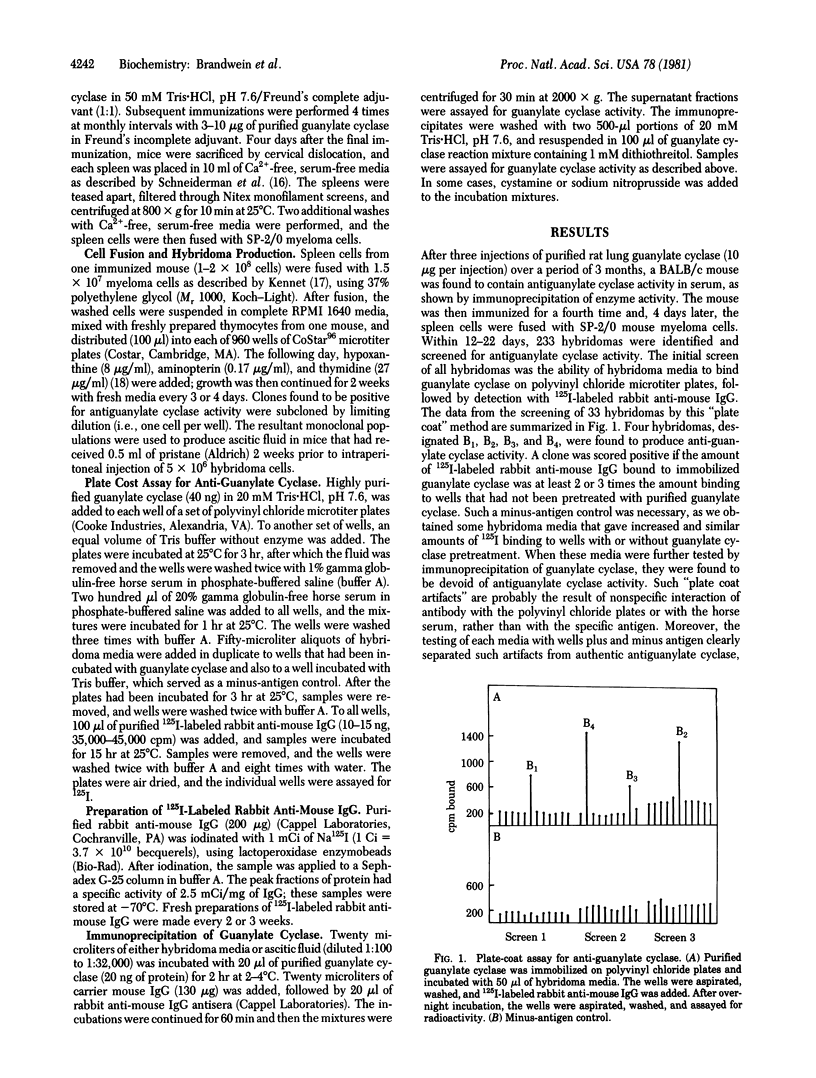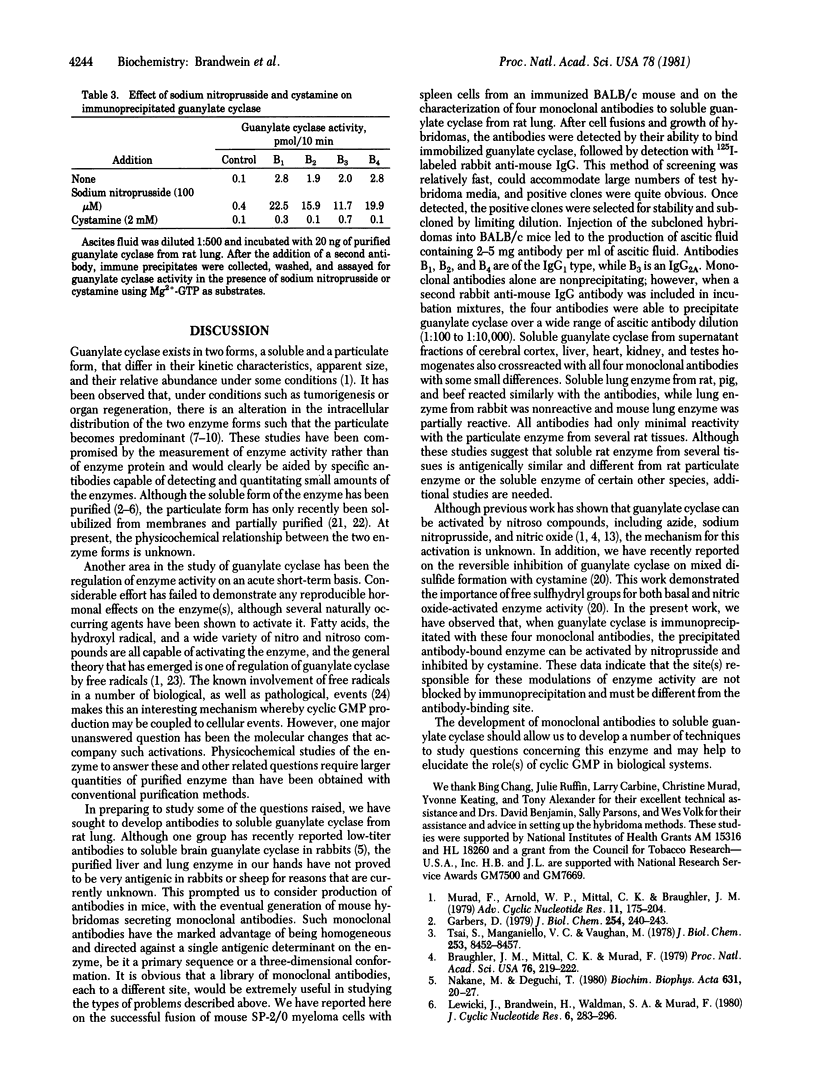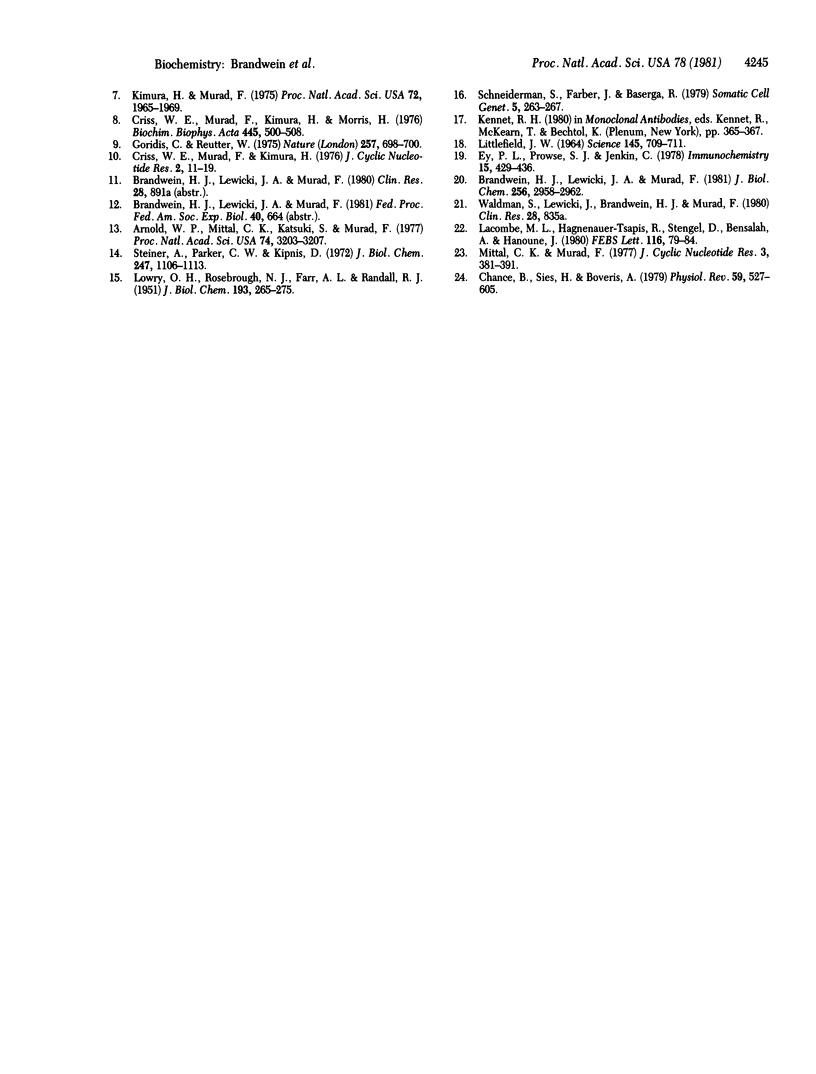Abstract
Four monoclonal antibodies to rat lung soluble guanylate cyclase [GTP pyrophosphate-lyase (cyclizing) EC 4.6.1.2] have been produced by fusing spleen cells from immunized BALB/c mice with SP-2/0 myeloma cells. The antibodies were detected by their ability to bind immobilized guanylate cyclase and by immunoprecipitation of purified enzyme in the presence of second (rabbit anti-mouse) antibody. After subcloning by limiting dilution, hybridomas were injected intraperitoneally into mice to produce ascitic fluid containing 2-5 mg of antibody per ml. The four antibodies obtained had titers of between 1:1580 and 1:3160 but were detectable at dilutions greater than 1:20,000. Soluble guanylate cyclase from several rat tissues were crossreactive with the four monoclonal antibodies, suggesting that the soluble enzyme from different rat tissues is antigenically similar. The antibodies also recognized soluble lung enzyme from rat, beef, and pig, while enzyme from rabbit was not crossreactive and mouse enzyme was recognized by only one of the antibodies. Particulate guanylate cyclase from a number of tissues had only minimal crossreactivity with the antibodies. Immunoprecipitated guanylate cyclase retained catalytic activity, could be activated with sodium nitroprusside, and was inhibited by cystamine. None of the antibodies were inhibitory under the conditions examined. These antibodies will be useful probes for the study of guanylate cyclase regulation and function under a variety of physiological conditions.
Full text
PDF




Selected References
These references are in PubMed. This may not be the complete list of references from this article.
- Arnold W. P., Mittal C. K., Katsuki S., Murad F. Nitric oxide activates guanylate cyclase and increases guanosine 3':5'-cyclic monophosphate levels in various tissue preparations. Proc Natl Acad Sci U S A. 1977 Aug;74(8):3203–3207. doi: 10.1073/pnas.74.8.3203. [DOI] [PMC free article] [PubMed] [Google Scholar]
- Brandwein H. J., Lewicki J. A., Murad F. Reversible inactivation of guanylate cyclase by mixed disulfide formation. J Biol Chem. 1981 Mar 25;256(6):2958–2962. [PubMed] [Google Scholar]
- Braughler J. M., Mittal C. K., Murad F. Purification of soluble guanylate cyclase from rat liver. Proc Natl Acad Sci U S A. 1979 Jan;76(1):219–222. doi: 10.1073/pnas.76.1.219. [DOI] [PMC free article] [PubMed] [Google Scholar]
- Chance B., Sies H., Boveris A. Hydroperoxide metabolism in mammalian organs. Physiol Rev. 1979 Jul;59(3):527–605. doi: 10.1152/physrev.1979.59.3.527. [DOI] [PubMed] [Google Scholar]
- Criss W. E., Murad F., Kimura H. Properties of guanylate cyclase from rat kidney cortex and transplantable kidney tumors. J Cyclic Nucleotide Res. 1976;2(1):11–19. [PubMed] [Google Scholar]
- Ey P. L., Prowse S. J., Jenkin C. R. Isolation of pure IgG1, IgG2a and IgG2b immunoglobulins from mouse serum using protein A-sepharose. Immunochemistry. 1978 Jul;15(7):429–436. doi: 10.1016/0161-5890(78)90070-6. [DOI] [PubMed] [Google Scholar]
- Garbers D. L. Purification of soluble guanylate cyclase from rat lung. J Biol Chem. 1979 Jan 10;254(1):240–243. [PubMed] [Google Scholar]
- Goridis C., Reutter W. Plasma membrane-associated increase in guanylate cyclase activity in regenerating rat liver. Nature. 1975 Oct 23;257(5528):698–700. doi: 10.1038/257698a0. [DOI] [PubMed] [Google Scholar]
- Kimura H., Murad F. Increased particulate and decreased soluble guanylate cyclase activity in regenerating liver, fetal liver, and hepatoma. Proc Natl Acad Sci U S A. 1975 May;72(5):1965–1969. doi: 10.1073/pnas.72.5.1965. [DOI] [PMC free article] [PubMed] [Google Scholar]
- LITTLEFIELD J. W. SELECTION OF HYBRIDS FROM MATINGS OF FIBROBLASTS IN VITRO AND THEIR PRESUMED RECOMBINANTS. Science. 1964 Aug 14;145(3633):709–710. doi: 10.1126/science.145.3633.709. [DOI] [PubMed] [Google Scholar]
- LOWRY O. H., ROSEBROUGH N. J., FARR A. L., RANDALL R. J. Protein measurement with the Folin phenol reagent. J Biol Chem. 1951 Nov;193(1):265–275. [PubMed] [Google Scholar]
- Lacombe M. L., Haguenauer-Tsapis R., Stengel D., Ben Salah A., Hanoune J. Solubilization by proteolysis of an activated form of rat liver membrane guanylate cyclase. FEBS Lett. 1980 Jul 11;116(1):79–84. doi: 10.1016/0014-5793(80)80533-3. [DOI] [PubMed] [Google Scholar]
- Lewicki J. A., Brandwein H. J., Waldman S. A., Murad F. Purified guanylate cyclase: characterization, iodination and preparation of monoclonal antibodies. J Cyclic Nucleotide Res. 1980;6(4):283–296. [PubMed] [Google Scholar]
- Mittal C. K., Murad F. Properties and oxidative regulation of guanylate cyclase. J Cyclic Nucleotide Res. 1977 Dec;3(6):381–391. [PubMed] [Google Scholar]
- Murad F., Arnold W. P., Mittal C. K., Braughler J. M. Properties and regulation of guanylate cyclase and some proposed functions for cyclic GMP. Adv Cyclic Nucleotide Res. 1979;11:175–204. [PubMed] [Google Scholar]
- Nakane M., Deguchi T. Production and properties of antibody to soluble guanylate cyclase purified from bovine brain. Biochim Biophys Acta. 1980 Aug 1;631(1):20–27. doi: 10.1016/0304-4165(80)90049-5. [DOI] [PubMed] [Google Scholar]
- Schneiderman S., Farber J. L., Baserga R. A simple method for decreasing the toxicity of polyethylene glycol in mammalian cell hybridization. Somatic Cell Genet. 1979 Mar;5(2):263–269. doi: 10.1007/BF01539165. [DOI] [PubMed] [Google Scholar]
- Steiner A. L., Parker C. W., Kipnis D. M. Radioimmunoassay for cyclic nucleotides. I. Preparation of antibodies and iodinated cyclic nucleotides. J Biol Chem. 1972 Feb 25;247(4):1106–1113. [PubMed] [Google Scholar]


